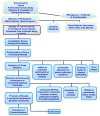Development and successful application of a "Community-First" communication model for community-based environmental health research
- PMID: 19209035
- PMCID: PMC3074972
- DOI: 10.1097/JOM.0b013e3181965d9b
Development and successful application of a "Community-First" communication model for community-based environmental health research
Abstract
Objectives: Effectively communicate results from a community exposure study to meet predetermined community priorities, maintaining ethical principles of autonomy, empowerment and justice.
Methods: The community established principles for the communications and a plan to inform study participants, community and other stakeholders of results and recommendations in a novel sequence: the "Community-First" communication model.
Results: The communications resulted in positive actions including company sponsored free bottled water, accepted by 77.6% of eligible households. Over 95% of participants in a follow-up survey had made some change to residential water supplies. Serum perfluorooctanoate levels were reduced. Government agencies acted on the results.
Conclusions: The unique communication approach generated workable solutions to the problem investigated, raised community awareness and modified behaviors. Information generated a "free market" of community-level solutions. Each major stakeholder voluntarily adopted a "precautionary principle."
Conflict of interest statement
The authors declare they have no competing financial interests.
Figures



Similar articles
-
Risk management frameworks for human health and environmental risks.J Toxicol Environ Health B Crit Rev. 2003 Nov-Dec;6(6):569-720. doi: 10.1080/10937400390208608. J Toxicol Environ Health B Crit Rev. 2003. PMID: 14698953 Review.
-
[PFASs pollution in Veneto Region (Northern Italy). After USA, it is the turn of Italy].Epidemiol Prev. 2017 Sep-Dec;41(5-6):232-236. doi: 10.19191/EP17.5-6.P232.079. Epidemiol Prev. 2017. PMID: 29119753 Italian. No abstract available.
-
Design, methods, and population for a study of PFOA health effects among highly exposed mid-Ohio valley community residents and workers.Environ Health Perspect. 2013 Aug;121(8):893-9. doi: 10.1289/ehp.1206450. Epub 2013 Jun 4. Environ Health Perspect. 2013. PMID: 23735518 Free PMC article.
-
Private drinking water wells as a source of exposure to perfluorooctanoic acid (PFOA) in communities surrounding a fluoropolymer production facility.Environ Health Perspect. 2011 Jan;119(1):92-7. doi: 10.1289/ehp.1002503. Epub 2010 Oct 4. Environ Health Perspect. 2011. PMID: 20920951 Free PMC article.
-
United States Environmental Protection Agency's Perfluorooctanoic Acid, Perfluorooctane Sulfonic Acid, and Related Per- and Polyfluoroalkyl Substances 2024 Drinking Water Maximum Contaminant Level: Part 2 - Fifteen Misconceptions About the Health Hazards.Crit Rev Toxicol. 2025;55(3):368-415. doi: 10.1080/10408444.2024.2446453. Epub 2025 May 20. Crit Rev Toxicol. 2025. PMID: 40391660 Review.
Cited by
-
Moving Forward with Reporting Back Individual Environmental Health Research Results.Environ Health Perspect. 2023 Dec;131(12):125002. doi: 10.1289/EHP12463. Epub 2023 Dec 14. Environ Health Perspect. 2023. PMID: 38095662 Free PMC article.
-
Implications of the GC-HARMS Fishermen's Citizen Science Network: Issues Raised, Lessons Learned, and Next Steps for the Network and Citizen Science.New Solut. 2019 Feb;28(4):570-598. doi: 10.1177/1048291118810871. Epub 2018 Nov 15. New Solut. 2019. PMID: 30439292 Free PMC article.
-
Community Engagement and Research Translation in Puerto Rico's Northern Karst Region: The PROTECT Superfund Research Program.New Solut. 2016 Nov;26(3):475-495. doi: 10.1177/1048291116667715. New Solut. 2016. PMID: 30081770 Free PMC article.
-
Community First Communication: Reversing Information Disparities to Achieve Environmental Justice.Environ Justice. 2010 Sep 1;3(3):79-84. doi: 10.1089/env.2009.0037. Environ Justice. 2010. PMID: 21546988 Free PMC article.
-
Public Participation, Trust and Data Sharing: Gardens as Hubs for Citizen Science and Environmental Health Literacy Efforts.Int J Sci Educ B Commun Public Engagem. 2019;9(1):54-71. doi: 10.1080/21548455.2018.1542752. Epub 2018 Nov 7. Int J Sci Educ B Commun Public Engagem. 2019. PMID: 31485378 Free PMC article.
References
-
- Presidential/Congressional Commission on Risk Assessment and Risk Management. Framework for Environmental Health Risk Management - Final Report Vols 1 and 2. Washington, DC: U.S. Environmental Protection Agency; 1997.
-
- Cuoto RA, Simpson NK, Harris G. Sowing Seeds in the Mountains: Community-Based Coalitions for Cancer Prevention and Control. Bethesda, MD: Appalachia Leadership Initiative on Cancer, DCPC, National Cancer Institute; 1994. pp. 14–28. NIH publication 94–377.
-
- Bodenheimer T. Uneasy Alliance Clinical Investigators and the Pharmaceutical Industry. N Engl J Med. 2000;342:1539–1544. - PubMed
-
- O’Fallon LR, Tyson FL, Dearry A, editors. Successful Models of Community-Based Participatory Research: Final Report. Research Triangle Park, NC: National Institute of Environmental Health Sciences; 2000.
-
- Shepard PM, Northridge ME, Prakash S, Stover G. Preface: advancing environmental justice through community- based participatory research. Environ Health Pers. 2002;110 (Suppl 2):139–140.
Publication types
MeSH terms
Substances
Grants and funding
LinkOut - more resources
Full Text Sources
Medical

